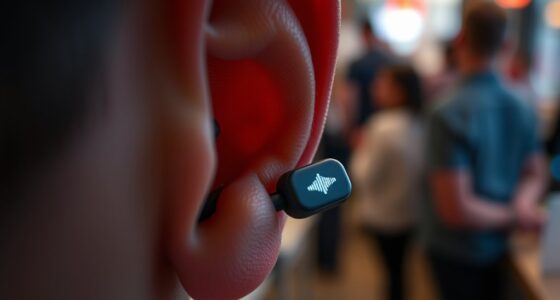Micro‑stretching provides quick, 30-second mobility breaks that your joints crave to stay healthy and flexible. By doing simple exercises like neck rolls, shoulder shrugs, or wrist stretches, you boost circulation, reduce stiffness, and improve joint function—all without disrupting your busy schedule. These brief movements support cartilage health and prevent discomfort, helping you stay active and responsive throughout the day. Keep going to discover tips on customizing and seamlessly incorporating micro‑stretching into your routine.
Key Takeaways
- Micro-stretching involves quick, 30-second routines that boost joint mobility and reduce stiffness effectively.
- Short movement breaks improve circulation, lubricate joints, and enhance overall joint health.
- Easy exercises like neck rolls and shoulder shrugs can be integrated into daily routines without disruption.
- Personalizing stretches ensures safety, prevents injury, and targets specific tight areas efficiently.
- Regular micro-stretching supports long-term flexibility, reduces discomfort, and maintains joint responsiveness.
Why Micro‑Stretching Matters for Joint Health
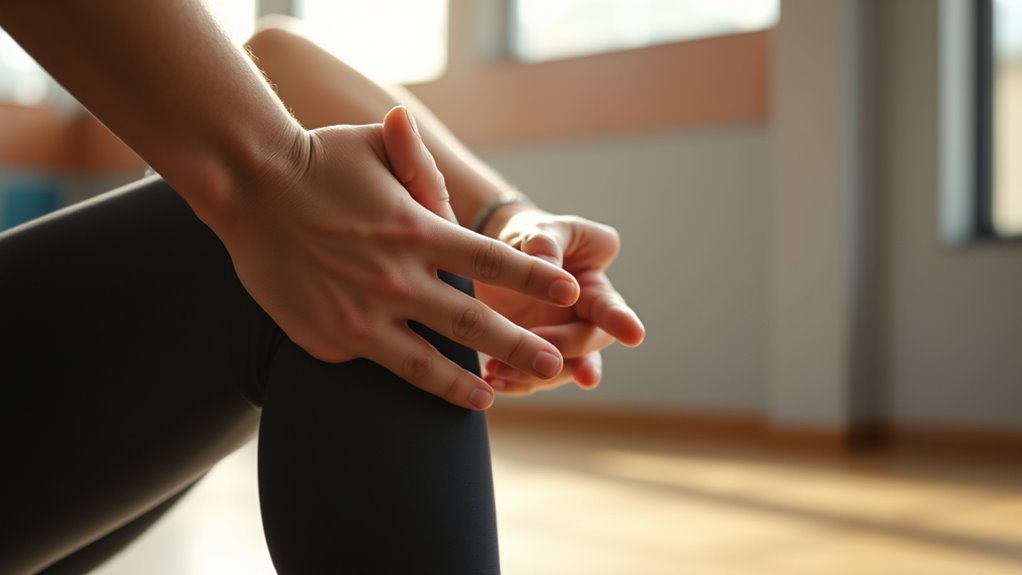
Micro-stretching plays a crucial role in maintaining joint health because it gently increases flexibility and reduces stiffness. When you regularly perform micro-stretches, you improve joint flexibility, making movements smoother and less painful. This enhanced mobility helps prevent joint deterioration over time. Additionally, micro-stretching supports cartilage preservation by promoting proper joint function. When your joints move through their full range of motion, it encourages nutrient flow to the cartilage, helping to keep it healthy and resilient. Consistent micro-stretching can delay the onset of stiffness and joint-related issues, especially as you age. By incorporating these brief, gentle stretches into your daily routine, you actively contribute to healthier, more flexible joints and better overall mobility.
Easy Micro‑Stretching Exercises to Incorporate Daily
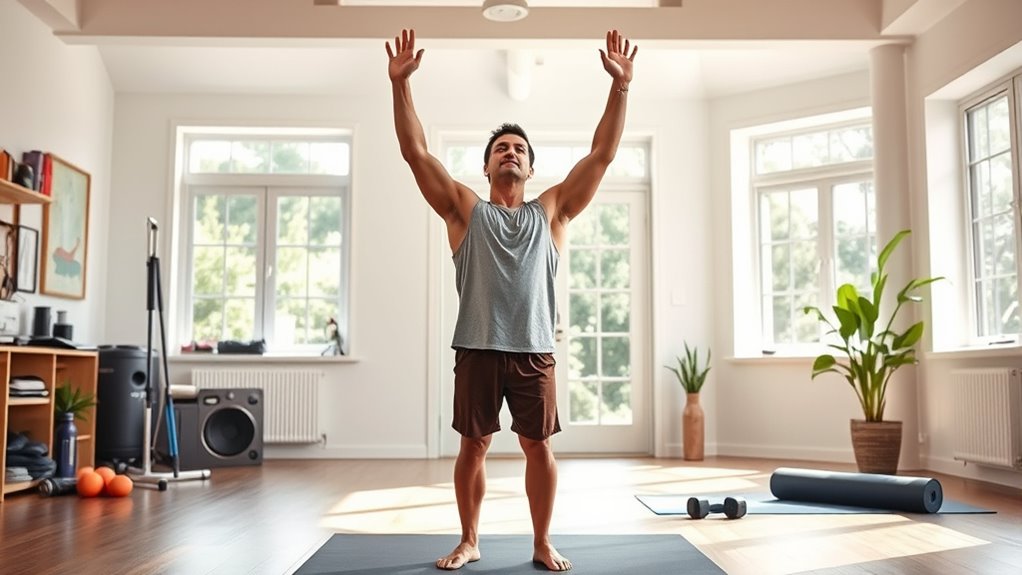
Incorporating simple micro-stretching exercises into your daily routine can markedly boost joint flexibility and reduce stiffness. Many stretching myths suggest you need long, intense sessions, but understanding joint anatomy shows quick, targeted moves are enough. Here are easy exercises to try:
- Neck rolls: Gently rotate your neck to loosen tension and improve mobility.
- Shoulder shrugs: Lift and roll your shoulders to enhance joint function.
- Wrist stretches: Extend and flex your wrists to prevent stiffness from daily tasks.
- Hamstring pulls: Lightly stretch your hamstrings to support proper hip and knee movement. Engaging in these brief stretches can also help dispel common stretching myths and promote a better understanding of joint health. These brief moves keep your joints healthy, dispel myths about stretching, and fit seamlessly into busy days, making micro-stretching an essential habit. Additionally, understanding the importance of color accuracy in visual clarity can help you appreciate how proper movement and alignment benefit overall joint health and function.
Benefits of Short Movement Breaks Throughout the Day

Taking short movement breaks can boost your circulation instantly, helping you feel more alert. They also reduce muscle stiffness, making it easier to stay comfortable throughout the day. Plus, these quick breaks enhance your focus and energy levels, keeping you productive and refreshed. Incorporating movement breaks into your routine can also support long-term joint health and flexibility. Additionally, research into AI safety highlights the importance of continuous monitoring, which parallels how regular movement checks help maintain joint health over time. Proper placement and effective air quality management can further enhance your overall well-being during these breaks.
Boosts Circulation Instantly
Short movement breaks can give your circulation an immediate boost, helping blood flow more efficiently through your body. This increase in circulation promotes joint lubrication, reducing discomfort, and stimulates your nerves, keeping you alert. When you move briefly, you’ll experience:
- A surge of energy, making you feel more awake and focused.
- Faster delivery of oxygen and nutrients to tissues, supporting overall health.
- Enhanced joint health as fluids circulate better, easing stiffness. Incorporating auto functionality can further improve your movement efficiency.
- Heightened nerve stimulation, sharpening your reflexes and mental clarity. Regularly incorporating these breaks can also prevent stagnation, ensuring your joints stay healthy and your body stays responsive. By breaking up long periods of sitting, you activate essential systems that keep you energized and comfortable throughout the day.
Reduces Muscle Stiffness
By moving briefly throughout the day, you can effectively reduce muscle stiffness that often develops from prolonged sitting or inactivity. Short movement breaks help promote muscle relaxation, preventing muscles from tightening up and becoming sore. When you stretch or move, you encourage better joint lubrication, which keeps joints fluid and reduces discomfort. These quick stretches loosen tight muscles, making movement easier and more comfortable. Regularly breaking up your day with micro-stretching prevents muscles from becoming stiff and keeps them loose and responsive. Incorporating these brief activity pauses ensures your muscles stay relaxed, joints stay lubricated, and stiffness stays at bay throughout your busy day. Additionally, dynamic movement during these breaks can further enhance joint mobility and reduce stiffness.
Enhances Focus and Energy
When you incorporate brief movement breaks into your day, you can considerably boost your focus and energy levels. These micro‑stretching sessions act as quick mindfulness practices, grounding you in the present moment and clearing mental fog. By taking just 30 seconds to stretch, you’ll experience:
- Renewed mental clarity that sharpens decision making
- Increased alertness to stay engaged longer
- Reduced fatigue, keeping you motivated
- A sense of control over your well-being, boosting confidence
- Vetted privacy policies ensure your data and preferences are respected during these quick breaks.
These small movements disrupt sedentary routines, helping your mind reset and refocus. As your body awakens, so does your mental energy, making it easier to tackle tasks with purpose. Incorporate these tiny breaks, and watch your productivity and mood soar.
Tips for Effective and Safe Micro‑Stretching

To get the most benefit from micro-stretching while avoiding injury, it’s vital to follow some key safety tips. First, warm up briefly to improve joint flexibility and prepare your muscles. Never push into pain—stretching safety means feeling gentle tension, not discomfort. Focus on controlled movements, avoiding jerky or rapid motions. Keep your stretches within a comfortable range to prevent overstretching. Remember to breathe steadily throughout each stretch.
| Tip | Why It Matters | Example |
|---|---|---|
| Warm up first | Prevents injury, enhances joint flexibility | Light cardio for 2 min |
| No pain | Ensures safe stretching, avoids overstretching | Stop if uncomfortable |
| Breathe deeply | Maintains relaxation and control | Inhale, exhale smoothly |
| Controlled movements | Promotes stretching safety | Slow, steady stretches |
| Respect limits | Protects joints and muscles | Ease into each stretch |
How to Customize Your 30-Second Mobility Routine
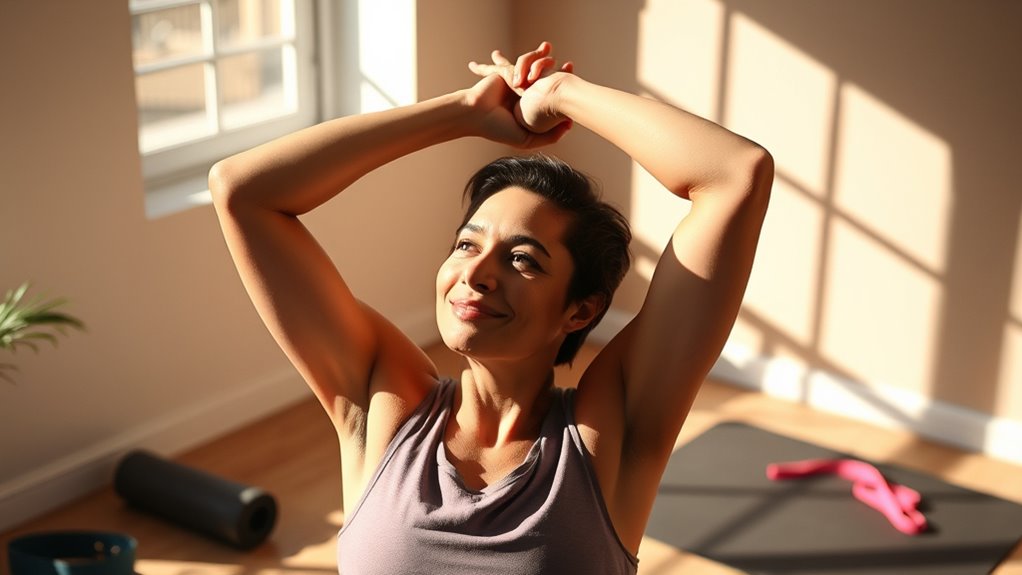
Customizing your 30-second mobility routine allows you to target specific areas and fit quick movement sessions into your busy day. To create personalized routines, consider these steps:
Tailor your 30-second mobility routine to target key areas and fit quick, effective movement into your busy schedule.
- Identify your tight spots—whether it’s shoulders, hips, or wrists—and focus on those areas.
- Mix in stretch variations to keep your routine fresh and effective, preventing boredom.
- Adjust intensity based on how your joints feel—gentle for recovery, deeper stretches for flexibility.
- Keep a mental or physical list of favorite moves so you can quickly select the most needed stretch in seconds.
Incorporating Micro‑Stretching Into a Busy Schedule
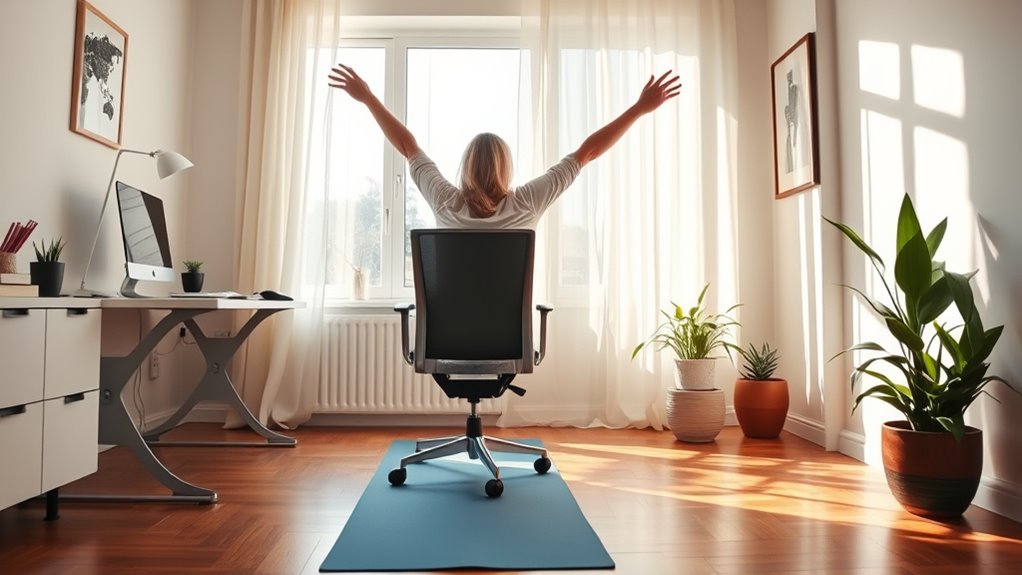
You can easily fit micro-stretching into your busy day by choosing quick, efficient exercises. Even a minute or two between meetings or during breaks can make a difference. With a little planning, you’ll maximize your mobility without disrupting your schedule.
Efficient Daily Routine
Even with a jam-packed schedule, fitting micro-stretching into your day is more achievable than you might think. Quick stretching techniques can seamlessly boost your joint mobility without disrupting your routine. Here’s how to make it work:
- Dedicate 30 seconds during your morning routine to stretch your neck and shoulders.
- Take advantage of breaks—stand up and do simple arm circles or torso twists.
- Incorporate micro-stretching into tasks, like stretching your legs while waiting for coffee.
- End your day with wrist and ankle stretches to relax tense joints.
Quick Stretch Integration
How can you seamlessly incorporate micro-stretching into a busy schedule? The key is to bust stretching myths that suggest long sessions are needed for benefits. Micro-stretching, just 30 seconds at a time, can boost your joint flexibility without sacrificing time. You can easily add these quick stretches between meetings, during breaks, or while waiting for your coffee. You don’t need to set aside a dedicated workout—small, intentional movements make a big difference. Remember, consistent micro-stretching helps improve joint health and dispels the misconception that flexibility only comes from lengthy routines. By integrating these brief stretches into your day, you support your joints and keep mobility high without disrupting your busy life.
Frequently Asked Questions
Can Micro‑Stretching Help With Chronic Joint Pain?
Chronic joint pain can be tough, but micro‑stretching might help. By improving joint flexibility, you can reduce stiffness and alleviate discomfort. Regular 30-second mobility breaks encourage blood flow and keep your joints active, potentially leading to better pain relief. While it’s not a cure-all, incorporating micro‑stretching into your routine can support joint health and make daily movements more comfortable, helping you manage chronic pain more effectively.
Are There Any Risks Associated With Micro‑Stretching?
Did you know that improper stretching can cause up to 30% of joint strain-related injuries? When you micro-stretch, there’s a small risk of muscle overstretch or joint strain if done incorrectly or too aggressively. To stay safe, focus on gentle movements, avoid forcing stretches, and listen to your body. Proper technique minimizes risks, ensuring your micro-stretching supports your joints without causing harm.
How Soon Can I Expect to See Results?
You might wonder how soon you’ll see results from micro-stretching. Typically, with consistent practice, you can notice increased mobility and reduced stiffness within a few weeks. To track your progress, keep a mobility journal or take regular videos. While effectiveness timelines vary, many people start feeling improvements in their joints and flexibility after about two to four weeks of daily micro-stretching, making patience and consistency key.
Is Micro‑Stretching Suitable for Elderly Individuals?
You might wonder if micro-stretching is suitable for elderly individuals. It is, because gentle stretches help improve balance and joint flexibility without overstraining. You can start with simple, low-intensity moves to see how your body responds. Regular micro-stretching can gradually enhance mobility, making daily activities easier. Always consult your healthcare provider first to ensure these gentle exercises fit your specific health needs.
What Equipment, if Any, Is Needed for Micro‑Stretching?
It’s interesting how often people overlook the equipment needed for micro-stretching, yet the truth is, you don’t need much. Typically, only minimal equipment or no tools at all are required. You can perform most stretches using just your body weight, a sturdy chair, or a wall for support. This simplicity makes micro-stretching accessible anywhere, anytime, fitting seamlessly into your daily routine without needing specialized gear.
Conclusion
In just 30 seconds a few times a day, you can markedly boost your joint health and flexibility. Studies show that incorporating micro-stretching can reduce stiffness and improve mobility, especially for those with sedentary lifestyles. By making these quick movement breaks a habit, you’re investing in long-term joint comfort and function. So, start today—you’ll likely notice easier movement and less discomfort, proving that even tiny efforts lead to big health benefits.

